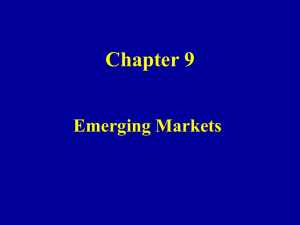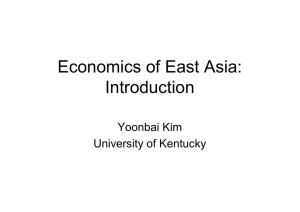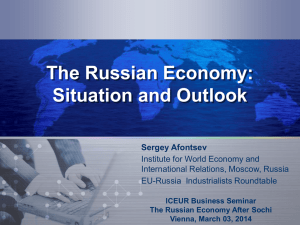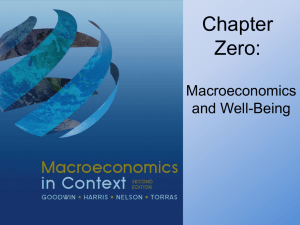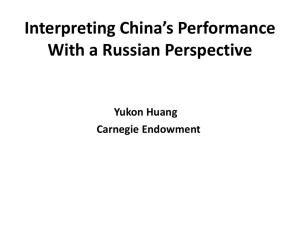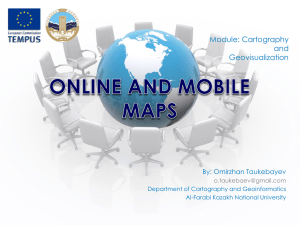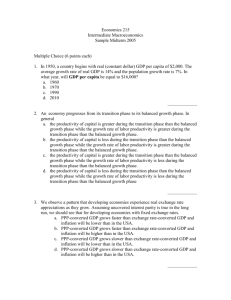Lectures-5-6
advertisement
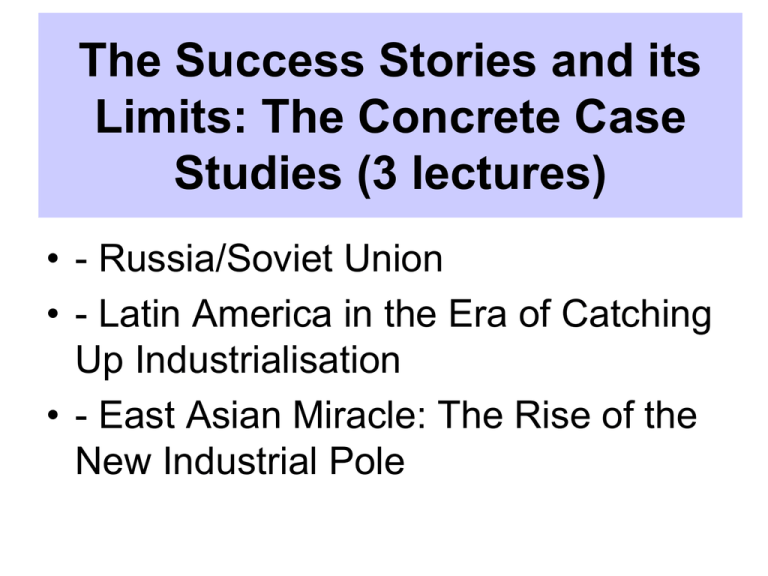
The Success Stories and its Limits: The Concrete Case Studies (3 lectures) • - Russia/Soviet Union • - Latin America in the Era of Catching Up Industrialisation • - East Asian Miracle: The Rise of the New Industrial Pole The empire model of modernisation • Goals • Means • – maintenance of military-political power, ability to defensive and offensive war • – modernisation of army & the state governance, selective borrowings of the advanced technologies and scientific accomplishments important for militarisation The Rise of Dualism in Russia Army & military industry resources Exploitation of country-side Conservation of backwardness as the main obstacle to further modernisation Alexander Pushkin on the internal central-peripheral structure of Russia • • • • • • • • • • “Whatever for caprice of spending ingenious London has been sending across the Baltic in exchange for wood and tallow; all the range of useful objects that the curious Parisian taste invents for one – for friends of languor, or of fun, or for the modishly luxurious – all this, at eighteen years of age adorned the sanctum of our sage.” (Eugene Onegin) GDP per capita in some countries of Latin America and Europe (including Russia), 1870-1938 Countries Absolute amount of GDP per capita, measured by PPP (in dollars of 1990) The ratio of countries’ GDP per capita to the world average 1870 1900 1913 1929 1938 1870 1900 1913 1929 1938 France 1 858 2 849 3 452 4 666 4 424 2.02 2.18 2.17 2.47 2.30 Germany 1 913 3 134 3 833 4 335 5 126 2.08 2.40 2.41 2.30 2.67 United Kingdom 3 263 4 593 5 032 5 255 5 983 3.55 3.52 3.16 2.79 3.11 Russia/USSR 1 023 1 218 1 488 1 386 2 150 1.11 0.93 0.93 0.74 1.12 Argentina 1 311 2 756 3 797 4 367 4 072 1.43 2.11 2.39 2.32 2.12 Brazil 740 704 839 1 106 1 291 0.80 0.54 0.53 0.59 0.67 Chile - 1 949 2 653 3 396 3 139 - 1.49 1.67 1.80 1.63 710 1 157 1 467 1 489 1 380 0.77 0.89 0.92 0.79 0.72 - 821 1 104 3 426 4 144 - 0.63 0.69 1.82 2.15 920 1 305 1 592 1 884 1 923 1.00 1.00 1.00 1.00 1.00 Mexico Venezuela World in average *) For comparison of Uruguay with Denmark • Dieter Sengaas. The European Experience: A Historical Critique of Development Theory. Leamington Spa, Dover (N.H.): Berg Publishers, 1985 (1-st published in Frankfurt-amMain, 1982, in German) The ratio of some Latin American and European countries’ (including Russia/USSR) GDP per capita to the world average, 1929-1970 Countries 1929 1938 1950 1960 1970 France 2. 47 2. 30 2. 33 2. 55 2. 92 Germany/FRG 2. 30 2. 67 1. 91 2. 89 3. 03 United Kingdom 2. 79 3. 11 3. 14 2. 92 2. 70 Russia/USSR 0. 74 1. 12 1. 27 1. 34 1. 40 Argentina 2. 32 2. 12 2. 23 1. 90 1. 84 Brazil 0. 59 0. 67 0. 75 0. 80 0. 77 Chile 1. 80 1. 63 1. 71 1. 47 1. 32 Mexico 0. 79 0. 72 0. 93 0. 95 0. 95 Venezuela 1. 82 2. 15 3. 32 3. 32 2. 73 World in average *) 1. 00 1. 00 1. 00 1. 00 1. 00 Limits of Import Substitution Industrialisation to itself (Latin America) • 1) A shortage of material, financial, and human resources; • 2) Conservation of the internal centralperipheral structure; • 3) Necessity to enlarge importation of capital goods and to maintain the traditional export; • 4) Impossibility to redistribute national income in extending degree The structure of the external trade of Brazil, 19601984 100% 0,3% 0,1% 90% 80% 58,5% 70% 60% 50% Other Primary goods Manufactured goods 97,5% 40% 30% 41,4% 20% 10% 0% 2,2% Brazil – dynamics of GDP (1965-1980) and the public external debt (1965-1975) 5,0 4,5 4,0 1965 = 1,0 3,5 3,0 2,5 2,0 1,5 1,0 0,5 0,0 GDP, 1965-1980 The public external debt, 1965-1975 Brazil – skyrocketing growth of the external debt, 1978 – 1980 – 1985, billions US$ 120,000 101,920 100,000 80,000 70,025 60,000 52,285 40,000 20,000 0,000 Two generations of ‘tigers’ • • • • • The first-tier ‘tigers’ - Hong Kong - Singapore - Taiwan - South Korea • The second-tier ‘tigers’ • - Malaysia • - Thailand • - Indonesia (‘semitiger’) • - The Philippines (‘under-tiger’) GDP p/c (US$ of 1990 on PPP) – 1960-19701980-1990 20000 18000 16000 14000 12000 10000 8000 6000 4000 2000 0 Brazil Mexico Hong Kong Singapore Taiwan South Korea Ghana Congo, DR (Zaire) GDP p/c (US$ of 1990 on PPP) – 1960-19701980-1990 1960 1970 1980 1990 Brazil 2335 3057 5198 4923 Mexico 3155 4320 6289 6119 Hong Kong 3134 5695 10503 17541 Singapore 2310 4439 9058 14365 Taiwan 1492 2980 5869 9886 South Korea 1105 1954 4114 8704 Ghana 1378 1424 1157 1063 Congo, DR (Zaire) 755 782 617 525 Flying Geese Model • K. Akamatsu. A Historical Pattern of Economic Growth in Developing Countries. – The Developing Economies, vol. 1, N 1, March – August 1962. • P. Korhonen. The Theory of the Flying Geese Pattern of Development and Its Interpretations. –Journal of Peace Research, vol. 31, N 1, 1994. • M. Tateishi. Southeast Asian Flying Geese? – In: Southeast Asia’s Misunderstood Miracle: Industrial Policy and Economic Development in Thailand, Malaysia and Indonesia. Ed. by K. S. Jomo. Boulder (Col.), Oxford: Westview Press, 1997. • UNCTAD. Trade and Development Report 1996. N.Y., Geneva: UN, 1996, pp. 75-81. The gross internal investments in fixed capital, as percentage of GDP, in East/Southeast Asian Newly Industrialising Countries, 1970-1995 Years Countries 1970 1975 1980 1985 1990 1995 Hong Kong 18.6 19.3 33.2 21.5 26.1 30.6 Korea 24.5 25.6 32.1 28.6 37.3 36.7 Singapore 32.5 35.1 40.7 42.2 32.5 33.7 Taiwan, prov. n. a. n. a. n. a. 18.8 22.4 22.9 13.6 a) 20.3 a) 20.9 b) 23.1 28.3 28.4 Malaysia 16.1 25.1 31.1 36.3 32.4 43.0 Thailand 24.1 22.3 25.2 27.2 40.4 41.1 Indonesia The gross internal investments in fixed capital, as percentage of GDP, in East/Southeast Asian Newly Industrialising Countries, 1970-1975-1980-1985-1990-1995 45,0 50,0 40,0 45,0 35,0 40,0 35,0 30,0 30,0 25,0 25,0 20,0 20,0 15,0 15,0 10,0 10,0 5,0 5,0 0,0 0,0 Hong Kong Korea Singapore Taiwan Indonesia Malaysia Thailand The Developmental State • The Developmental State. Ed. by Meredith Woo-Cumings. Ithaca – London: Cornell University Press, 1999 • Ha-Joon Chang. The East Asian Development Experience: The Miracle, the Crisis and the Future. London – New York: Zed Books, 2006 The colonial heritage and development
